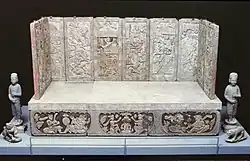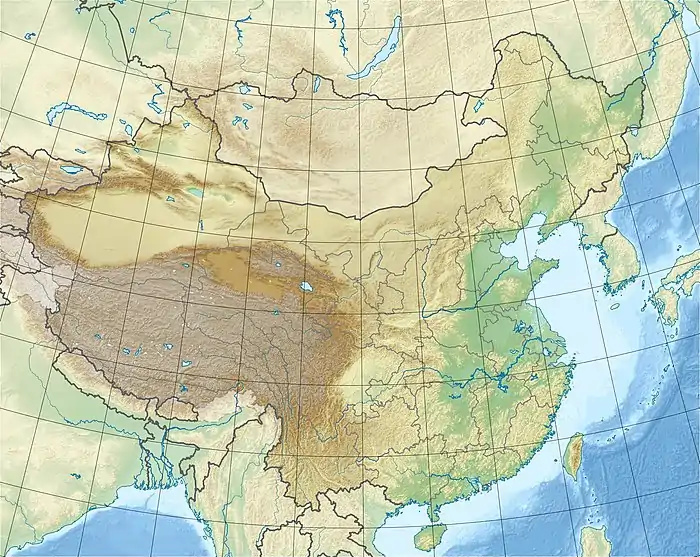Kooros couch
The Kooros couch is a 6-7th century (Northern Zhou/Sui dynasty) funeral monument to an anonymous Sogdian nobleman and official in northern China (the epitaph has been lost).[1] The tomb was probably discovered in the northern city of Tianshui in a clandestine excavation. It belonged to the "Vahid Kooros collection" after which it was named, and was briefly presented in the Musée Guimet in 2004, but has since disappeared.[2] It is one of the major known examples of Sogdian tombs in China.[3]
| Kooros couch | |
|---|---|
 The Kooros couch, Vahid Kooros Collection.[1] | |
| Created | 557-618 CE |
| Discovered | Tianshui, Northern China |
| Present location | Gansu Provincial Museum |
.png.webp) Tianshui  Tianshui | |
| Sogdian tombs in China | ||||||||||||||||||
|---|---|---|---|---|---|---|---|---|---|---|---|---|---|---|---|---|---|---|
|
||||||||||||||||||
The stone couch, similar to other Sogdian tombs in China and contemporary Chinese tombs, is composed of a pedestal with stone slabs around the couch, decorated with reliefs showing the life of the deceased and scene of the afterlife, particularly hunting, drinking and feasting.[4][5][2] The iconography of the panels is rather excentric, or "Bacchic".[2][6]
Given the iconographical content of the tomb, the owner may not have been Sogdian, but rather may have originated from northern India or Tokharistan (Bactria).[7]
See also
References
- Hongnam, Kim (2020). "A Study of Stone-joint Metal Clamps in China and Korea during the 6th-8th Centuries" (PDF). The Silk Road. 18: 88.
- GRENET, Frantz (2020). Histoire et cultures de l'Asie centrale préislamique. Paris, France: Collège de France. p. 328-329. ISBN 978-2-7226-0516-9.
- Lerner, Judith A. (2005). "ASPECTS OF ASSIMILATION: THE FUNERARY PRACTICES AND FURNISIDNGS OF CENTRAL ASIANS IN CHINA" (PDF). Sino-Platonic Papers. 168.
- CHENG, BONNIE (2010). "THE SPACE BETWEEN: Locating "Culture" in Artistic Exchange". Ars Orientalis. 38: 90. ISSN 0571-1371. JSTOR 29550021.
- Bing, Huang (2021). "Deciphering the Shi Jun Sarcophagus Using Sogdian Religious Beliefs, Tales, and Hymns". Religions: 14.
- Compareti, Matteo (2016). "Flying over Boundaries Auspicious Birds in Sino-Sogdian Funerary Art" (PDF). Eurasiatica 5: 136.
- Lerner, Judith A. (2005). "ASPECTS OF ASSIMILATION: THE FUNERARY PRACTICES AND FURNISIDNGS OF CENTRAL ASIANS IN CHINA" (PDF). Sino-Platonic Papers. 168: 4.